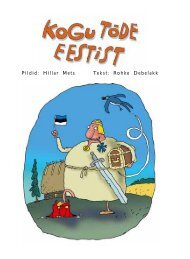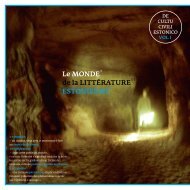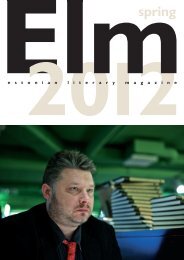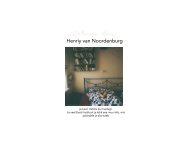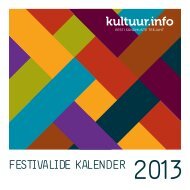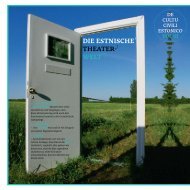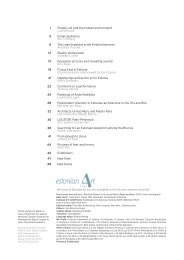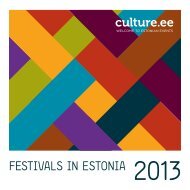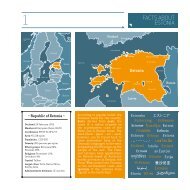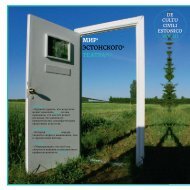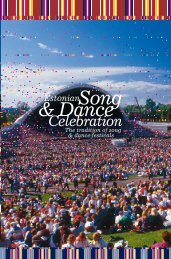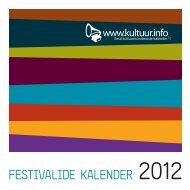Autumn 2013
Autumn 2013
Autumn 2013
Create successful ePaper yourself
Turn your PDF publications into a flip-book with our unique Google optimized e-Paper software.
Compared with the Death of the<br />
Dance of Death, the Life of the Dance of<br />
Life is tolerant, but also didactic and even<br />
moralising: having seen it all, it knows<br />
that there is no happy ending. The<br />
authors of Carmina burana knew this too.<br />
Their texts did not try to deny fear, but<br />
balanced it with some healthy moralising<br />
and satire.<br />
The dancers of the Kareva-Rooste<br />
Dance of Life are chaste and moderate<br />
people whose brains never lose control<br />
and whose dance never gets frantic. The<br />
teachings uttered by Life are witty and<br />
contain practical life philosophy. However,<br />
considering the fact that both of the<br />
authors are leading figures of their generation,<br />
whose forms of expression have<br />
never been particularly reserved, we<br />
would have expected that this vessel of<br />
exquisite form would have been filled with<br />
some stronger beverage, producing in<br />
readers a whirling after-effect.<br />
The contributions of each author<br />
are mysteriously unspecified. Sometimes<br />
it feels like Kareva is fulfilling the<br />
role of Life, but at other moments she<br />
is totally unrecognisable. Rooste’s<br />
seems to be the polite and more<br />
restricted voice.<br />
The book is made unique by its<br />
illustrations, showing fragments of a<br />
needlepoint blanket. The story of the<br />
embroiderer can be read on the last<br />
page of the book.<br />
The blanket was given to a<br />
shivering young girl in a refugee camp<br />
in post-war Germany by an American<br />
soldier. The blanket was ugly and the<br />
girl started to embroider it with patterns<br />
from Estonian folk costumes. Working<br />
sporadically, it took her about 20 years<br />
and a move to the other side of the<br />
world to finish the work and cover all of<br />
the blanket with embroidery. The<br />
blanket now resides in the Estonian<br />
National Museum. Isn’t this story also a<br />
fragment of the Dance of Life? RH<br />
Kristiina Ehin<br />
Paleontoloogi päevaraamat<br />
(Paleontologist’s Diary)<br />
OÜ Petrone Print <strong>2013</strong>, 270 pp<br />
ISBN: 9789949511280<br />
Starting in 2000, Kristiina Ehin (b. 1977) has<br />
published several prose books and collections<br />
of poetry. Paleontologist’s Diary, which<br />
appeared this year and has already become<br />
popular, is special among them: it is not easy<br />
to determine whether it is a book of prose or<br />
poetry, and its unclear character can be<br />
seen in its other aspects as well. This book<br />
is a prose text that is tightly interwoven with<br />
poems, written by the author as well as other<br />
people, from members of her family to Marie<br />
Under and Alexander Pushkin. In addition,<br />
the book contains many photos from private<br />
collections of different people. The photos<br />
have an illustrative role, but together with the<br />
book’s prose and poetry they form a unity,<br />
where prose fills the foreground, but by no<br />
means dominates the other components.<br />
This thrilling new book could be called a<br />
collage, carried by the voice of the first<br />
person narrator, who resembles Kristiina<br />
Ehin (the photos are mostly of Ehin). At the<br />
same time, it is not a simple life story. It<br />
focuses on the life of a young Estonian<br />
woman, but embraces so much other<br />
material that it is truly difficult to find the<br />
temporal and spatial frames of the text. The<br />
unrolling tale includes the narrator’s<br />
childhood and the stories of her parents and<br />
grandparents, and sends its roots even<br />
further into the past, finally reaching<br />
prehistory. Ehin puts together the history of<br />
her family and the country of Estonia and<br />
adds to it the whole of human existence: the<br />
narrator’s trains of thought link her with her<br />
genetic ancestor from 200 000 years ago,<br />
who may be the Ur-ancestor of all mankind.<br />
Life stories are much appreciated by<br />
contemporary readers and it isn’t surprising<br />
that a relatively young person would want to<br />
write her life story, although such a wish is<br />
more common among people at least a



